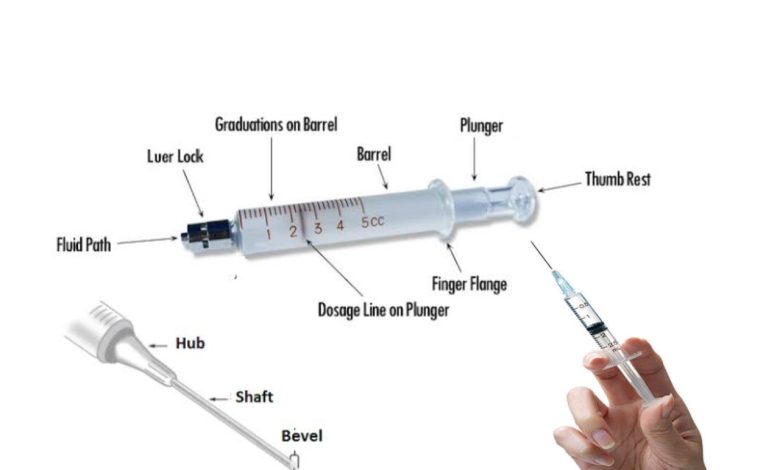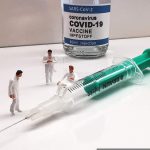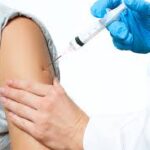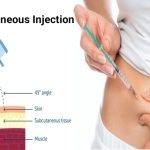12 Parts Of A Syringe and Their Functions

The syringe is a medical instrument used for injecting or withdrawing fluids from the body. The history of the syringe can be traced back to ancient times, with the use of hollow reeds, animal bladders, and other natural materials to transfer fluids.
The first known syringe was made of a hollow bird bone and was discovered in Egypt dating back to around 3000 BCE. Ancient Greeks and Romans used glass syringes for medical purposes, and in the Middle Ages, metal syringes were used for the same purpose.
However, it wasn’t until the mid-19th century that the modern syringe, as we know it today, was invented. In 1853, Alexander Wood, a Scottish physician, invented the hypodermic syringe, which is used for injecting medication directly into the bloodstream.
The hypodermic syringe was quickly adopted by medical professionals and became widely used for administering medication and vaccinations. However, its use also led to the spread of diseases such as HIV and hepatitis B and C due to the sharing of needles.
In the 20th century, the disposable syringe was introduced, which helped reduce the spread of diseases and made medical injections more convenient and safe. Today, syringes are used for a variety of medical purposes, including administering vaccines, drawing blood, and injecting medications.
Different Parts Of A Syringe And What They Do
A syringe is made up of several parts, each with its own specific function. The main parts of a syringe include:
1. Barrel: This is the cylindrical chamber of the syringe that holds the medication. It is usually made of plastic or glass and is marked with volume measurements to ensure accurate dosages.
2. Plunger: This is the movable part of the syringe that fits inside the barrel. It is used to draw the medication into the barrel and to push the medication out of the syringe when injecting.
3. Plunger tip: This is the flat or rounded end of the plunger that fits inside the barrel of the syringe. It is used to create a seal with the inside of the barrel and to help push the medication out of the syringe.
4. Graduations: These are markings on the barrel of the syringe that show the volume of medication being drawn into or pushed out of the syringe. Graduations are usually marked in milliliters (mL) or cubic centimeters (cc).
5. Rubber piston: This is a flexible rubber component that fits inside the barrel of some types of syringes. It is used to create a seal between the plunger and the inside of the barrel, preventing medication from leaking out.
6. Luer lock: This is a type of fitting on the end of the syringe barrel that allows a needle or other attachment to be securely screwed onto the syringe. Luer lock fittings are commonly used for medical procedures where a secure connection is important, such as during intravenous infusions.
7. Flange: This is a plastic or metal ring on the barrel of the syringe that can be used to attach a needle, a luer lock, or other fittings.
8. Needle: This is the sharp, pointed metal or plastic tip of the syringe that penetrates the skin and delivers the medication. Needles come in different lengths and gauges depending on their intended use.
9. Hub: This is the plastic or metal base of the needle that fits onto the end of the syringe barrel. It allows the needle to be securely attached and removed from the syringe.
10. Tip: This is the opening at the end of the needle where the medication is delivered. It can be a straight or angled tip, depending on the intended use.
11. Cap: This is a plastic cover that fits over the needle to protect it from contamination before use.
12. Safety features: Some syringes may have additional safety features, such as retractable needles or locking mechanisms to prevent accidental needle sticks.
Each part of the syringe plays a vital role in ensuring accurate dosages and safe delivery of medication. It is important to use the correct size and type of syringe for the intended use and to follow proper hygiene and disposal protocols to prevent the spread of infection.
Safety Protocols Associated with Handling Syringes
Handling syringes requires strict adherence to safety protocols to minimize the risk of infection or injury. Here are some key safety protocols associated with handling the different parts of a syringe:
1. When handling the barrel of a syringe, it is important to avoid touching the inside of the barrel to prevent contamination of the medication. Additionally, be sure to use the correct size and type of barrel for the intended use, and dispose of used barrels properly to prevent the spread of infection.
2. The plunger of a syringe should be handled with clean, dry hands to prevent contamination. Use gentle pressure when pushing the plunger to avoid damaging the barrel or needle, and avoid using forceful or sudden movements.
3. Needles should be handled with extreme caution to prevent needlestick injuries. Always use a new, sterile needle for each injection, and dispose of used needles in a puncture-resistant sharps container. Be sure to follow proper disposal protocols for used needles to minimize the risk of injury to others.
4. The hub of a needle should be held with clean, dry hands to prevent contamination. Be sure to use the correct size and type of hub for the intended use, and ensure that it is securely attached to the syringe before use.
5. The tip of the needle should be kept clean and free of contamination before use. Be sure to remove any protective caps or covers from the needle tip immediately before use, and avoid touching the tip to prevent contamination.
6. Caps should be removed from needles immediately before use and discarded properly. Do not reuse or reapply caps to used needles. The proper disposal of syringes and their parts is critical to prevent the spread of infection and to ensure the safety of healthcare workers and the general public. Here are some guidelines for disposing of the different parts of a syringe:
- After use, the barrel of the syringe should be disposed of in a puncture-resistant sharps container. This container is designed to prevent needlestick injuries and to contain any potential contamination. Sharps containers can be purchased at pharmacies or medical supply stores, or you can contact your local healthcare provider or waste management authority for information on disposal options in your area.
- The plunger of a syringe can be disposed of in the same sharps container as the barrel.
- Needles should be disposed of in a puncture-resistant sharps container immediately after use. Do not recap or bend the needle before disposal, as this increases the risk of needlestick injuries. If a sharps container is not available, needles can be disposed of in a hard plastic or metal container with a tight-fitting lid, such as a laundry detergent bottle or coffee can, that is labeled “Biohazard” or “Sharps”. Be sure to follow local regulations for the disposal of sharps containers.
- The hub of a needle can be disposed of in the same sharps container as the needle.
- The tip of a needle should be disposed of in the same sharps container as the needle.
- After removal, caps should be disposed of in a regular trash bin. Do not try to reapply or reuse caps on used needles, as this increases the risk of contamination and injury.
Overall, proper handling and disposal of used syringes and their parts are essential for maintaining a safe and hygienic healthcare environment. It is important to follow established safety protocols and to seek guidance from a healthcare professional if you are unsure about how to handle syringes or their parts safely.





